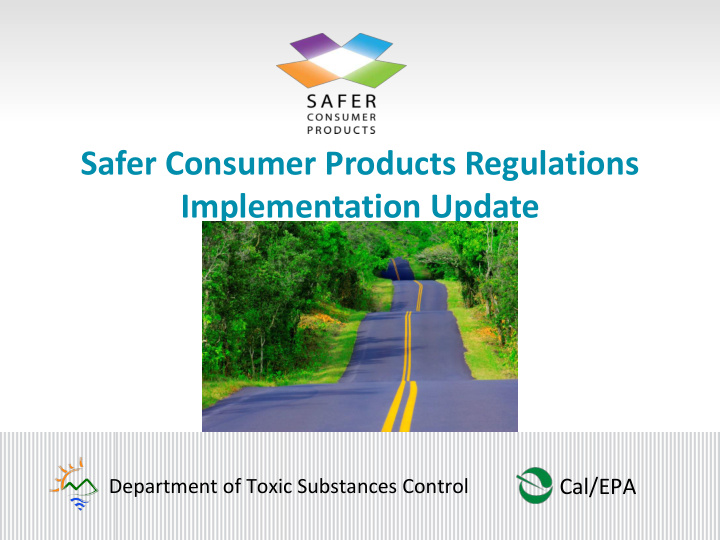



Safer Consumer Products Regulations Implementation Update Cal/EPA Department of Toxic Substances Control
How it Works: The SCP Regulations Candidate 1. Chemicals Chemicals List 2. Products Priority Products (Product-Chemical Combinations) 3. Alternatives Alternatives Selection Analysis 4. Regulatory Response
Candidate Chemicals Informational CC List published Work Plan list expands to >1,100 Online database update in October 2014
Priority Products Initial selections 1. Children’s Foam -padded Sleeping Products containing TDCPP 2. Paint Strippers containing Methylene Chloride 3. Spray Polyurethane Foam Systems with unreacted MDI Status Refined/revised scope and info on initial PPs Rulemaking to adopt proposed PP’s starting late this year PPWP is menu for next set of products
Initial Priority Products Revisions 1. Children’s Foam -padded Sleeping Products containing TDCPP o Added TCEP 2. Paint Strippers containing Methylene Chloride o No surface cleaners 3. Spray Polyurethane Foam Systems with MDI o Only unreacted MDI o Only two part foams
Alternatives Analysis Process to evaluate PPs for safer alternatives and avoid regrettable substitutes Guidance draft by year’s end Green Ribbon Science Panel will provide input; next meeting October 19-20, 2014
Regulatory Response (RR) No RRs will be initiated until after rulemaking is done and Alternative Analysis process is complete (2016-2017) 7 possible RRs No presumptions by DTSC on what a RR might be, or if a RR will be necessary
Draft Priority Products Work Plan
Work Plan Objectives Identify product categories for next 3 years Provide market signals Engage stakeholders, gather data, finalize the Work Plan… Then identify potential PPs
Process of Priority Product Selection: Finalizing the Work Plan
Process of Priority Product Selection: Executing the Work Plan
Purpose, goal & objective Solicit Input • Informal process/dialogue • Not rulemaking Answer clarifying questions Explain Work Plan process • How we picked categories • How we will we decide on PPs?
Product Categories Aligned with Global Product Classification (GPC) system when possible Purpose: Clearly describe what is covered within a category Categories are the starting point for research and dialogue
Lawn and Garden GPC Segment Supplies Lawn and Family Garden Supplies Furniture & Class Hand Tools Furnishings Garden Brick Rakes Hammocks Chairs
Product Category Selection SCP Regulations factors and criteria • Candidate Chemical • Potential exposure • Potential for significant adverse impact, etc. No ranking system or algorithm Screening approaches: • Hazard trait and end points • Sensitive Subpopulation • Routes of exposure • Functional Use • Chemical prioritization • Existing research • Evidence of Exposure information
Priorities for screening categories Dermal, ingestion, inhalation exposure pathways Biomonitoring results Chemicals in indoor air monitoring Sensitive subpopulations impacts Aquatic resource impacts Water quality monitoring evidence
Structure of Work Plan Categories Categories and sub-categories Product examples Example Candidate Chemicals and functional uses
7 Product Categories Beauty, Personal Care and Hygiene Products Building Products Household/Office Furniture/Furnishings Cleaning Products Clothing Fishing and Angling Equipment Office Machinery Consumable Products
Beauty, Personal Care and Hygiene • Products are applied directly to body • Volume and Frequency of use • Ingredients are not always disclosed • Biomonitoring • Potential impacts on aquatic environment
Building Products & Household/Office Furniture Time Indoors: California Children Direct pathways Enclosed transit 4% ‐ inhalation of indoor air Outdoors 10% and ingestion of dusts ‐ particularly by children Indoors other 10% Californians spend most of their time indoors Indoors at home 76% Jenkins et al. , 1992; Phillips et al . 1991
Building Products and Household/Office Furniture Greater exposure and impacts on children • Susceptible during development • Respiratory sensitivity • Time on floors • Fingers and objects in mouths Clear evidence of chemical presence with biomonitoring and indoor air studies Potential Health Impacts: • Asthma l Cancer l Irritant effects
Building Products Subcategories: • Paints • Adhesives • Sealants • Flooring
Household/Office Furniture Focus on specific classes of chemicals: • Flame retardants • Stain resistant chemicals (perfluorinated compounds)
Cleaning Products Pathways for Exposure: • Inhalation – Dermal - Aquatic Worker Exposure • 2.3 million custodial services workers • 1.4 million work hotel/healthcare facilities maids Hazard traits • Dermatotoxicity, respiratory toxicity, carcinogenicity • Work-related asthma
Clothing – chemical treatments Color fastness, wrinkle/stain resistance, and water repellency Manufacturing and laundering wastewater can contain Candidate Chemicals • Toxic • Bioaccumulative • Persistent
Fishing and Angling Equipment More than 2 million recreational anglers in CA Up to 225 metric tons of lead fishing weights may get into the environment each year Lead • Carcinogen, reproductive toxicant, neurotoxicant, and developmental toxicant • Persistent and bio-accumulative Sensitive species and ecosystems Water bird mortality well-documented
Office Machinery (Consumable Products) Printer inks Specialty paper Toner cartridges Potential long term exposures for office and retail workers Life cycle concerns – downstream processing or disposal
Providing Input Informal Comment Period • September 12 through October 13 Workshops • Sacramento September 25, 2014 • Cypress September 29, 2014
Submitting Comments: CalSAFER System Fast and Convenient Allows comment entry and upload of support documents Expedites the turn around and response time Allows users to review comments submitted by other stakeholders https://cit.dtsc.ca.gov/scp/comments/commentslite/
https://cit.dtsc.ca.gov/scp/comments/commentslite/
Comments, Questions and Information?? SaferConsumerProducts@dtsc.ca.gov https://cit.dtsc.ca.gov/scp/comments/commentslite/ http://www.dtsc.ca.gov/SCP DTSC
END OF PRESENTATION Cal/EPA Department of Toxic Substances Control
Recommend
More recommend